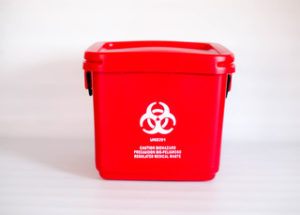Neighborhood Dedication: Your Area's Leading Medical Waste Removal Near Me
Neighborhood Dedication: Your Area's Leading Medical Waste Removal Near Me
Blog Article
Understanding the Different Sorts Of Waste Disposal Methods
In the world of waste management, the selection of disposal techniques readily available today is huge and varied, each technique offering a distinctive objective in dealing with the obstacle of waste disposal. click here. From reusing techniques that intend to give new life to products, to the elaborate procedures of harmful waste administration, the landscape of waste disposal is complicated yet critical for ecological sustainability. Recognizing the subtleties of these various techniques not only clarifies the importance of accountable waste administration however likewise prompts us to rethink our method towards garbage disposal in a rapidly evolving globe

Recycling Methods
Recycling methods are crucial for sustainable waste management practices in both property and commercial setups. medical waste removal service. By implementing effective recycling methods, a significant quantity of waste can be diverted from land fills, conserving all-natural sources and minimizing the ecological effect of production processes
In property locations, curbside recycling programs play a crucial duty in motivating families to different recyclable materials from basic waste. Materials such as paper, plastics, glass, and metals can be arranged and accumulated for handling right into brand-new products, reducing the demand for raw products and energy-intensive manufacturing processes.
Industrial centers also rely upon recycling approaches to decrease waste generation and promote a circular economy. By applying closed-loop systems, businesses can reuse materials within their production procedures, minimizing prices and ecological footprint. medical waste removal service. In addition, industrial recycling programs usually include partnerships with specialized reusing facilities to guarantee that materials are correctly arranged, refined, and reintegrated right into the supply chain
Composting Strategies

Oxygenated fixed heap composting involves blending natural waste materials in a large pile and regularly transforming it to make sure proper aeration. This technique is well-suited for smaller-scale operations and houses.
In-vessel composting entails positioning organic waste in a shut container with controlled problems for temperature and aeration. This technique is reliable for handling food waste in city areas. Windrow composting includes forming long rows of natural waste and on a regular basis turning them to advertise decay. This strategy is commonly utilized in agricultural setups.
Land Fill Disposal
Land fill disposal is a commonly used approach for managing waste that can not be reused or composted. Methane gas, a byproduct of breaking down natural waste in landfills, is commonly gathered and used as a source of renewable power. Initiatives to lower dependence on landfills consist of advertising waste decrease, recycling, and exploring alternative waste disposal methods to minimize the ecological impact linked with traditional landfill disposal methods.

Waste-to-Energy Incineration
Incineration of waste for power generation is an approach increasingly being taken into consideration as a choice to standard garbage dump disposal methods. Waste-to-energy incineration entails the burning of waste products at high temperature levels, usually in specialized facilities developed to produce electrical energy or warm through the procedure - click here. This technique not just lowers the volume of waste that would or else be destined for land fills but additionally harnesses the warm created throughout incineration to create energy
One of the essential advantages of waste-to-energy incineration is its ability to create electrical power while decreasing the ecological effect contrasted to conventional landfill disposal methods. By converting waste into energy, this method aids in decreasing greenhouse gas emissions and dependence on fossil gas for power generation. In addition, waste-to-energy facilities are furnished with innovative air pollution control innovations to reduce prospective toxic wastes launched during the combustion procedure.
Contaminated Materials Administration
.jpg)
Considering the vital value of accountable waste management methods, particularly in the world of environmental sustainability, the emphasis currently changes in the direction of the detailed domain of Hazardous Waste Management. Contaminated materials positions substantial risks to both human health and wellness and the setting, demanding customized handling and disposal strategies. Typical instances of contaminated materials consist of chemicals, batteries, chemicals, and electronic waste.
Contaminated materials Administration includes the recognition, collection, transport, therapy, and disposal of products considered hazardous or possibly harmful. This process requires adherence to stringent guidelines and guidelines to reduce adverse impacts on environments and public health and wellness. Numerous methods are utilized in managing contaminated materials, including recycling, secure landfills, encapsulation, and chemical treatment.
Proper Contaminated Materials Monitoring is important for avoiding contamination of soil, water resources, and air pollution. It is important for sectors, research laboratories, healthcare centers, and other generators of dangerous waste to implement durable management approaches, training programs, and emergency situation action intends to ensure the risk-free handling and disposal of these materials. Failing to take care of contaminated materials suitably can have far-reaching effects, emphasizing the importance of persistent see this site and accountable practices in this field.
Final Thought
To conclude, waste disposal methods play an essential function in handling and lessening the impact of waste on the setting. From recycling and composting to land fill disposal and waste-to-energy incineration, each approach has its very own benefits and constraints. Appropriate management of hazardous waste is likewise vital to secure public health and wellness and the atmosphere. It is crucial for people and industries to recognize the various garbage disposal strategies readily available and choose one of the most ideal approach for sustainable waste administration.
In the realm of waste administration, the array of disposal methods offered today is substantial and differed, each technique offering a distinct objective in dealing with the difficulty of waste disposal. click here. From reusing techniques that intend to offer brand-new life to products, to the complex processes of unsafe waste monitoring, the landscape of waste disposal is complex yet crucial for ecological sustainability. Recognizing the subtleties of these various techniques not only loses light on the relevance of liable waste monitoring yet likewise triggers us to reconsider our strategy in the direction of waste disposal in a quickly progressing world
Efforts to lower dependence on landfills consist of promoting waste reduction, recycling, and exploring different waste disposal approaches to minimize the ecological footprint connected with traditional land fill disposal practices.
It is crucial for individuals and sectors to recognize the different waste disposal techniques available and pick the most proper technique for sustainable waste monitoring.
Report this page